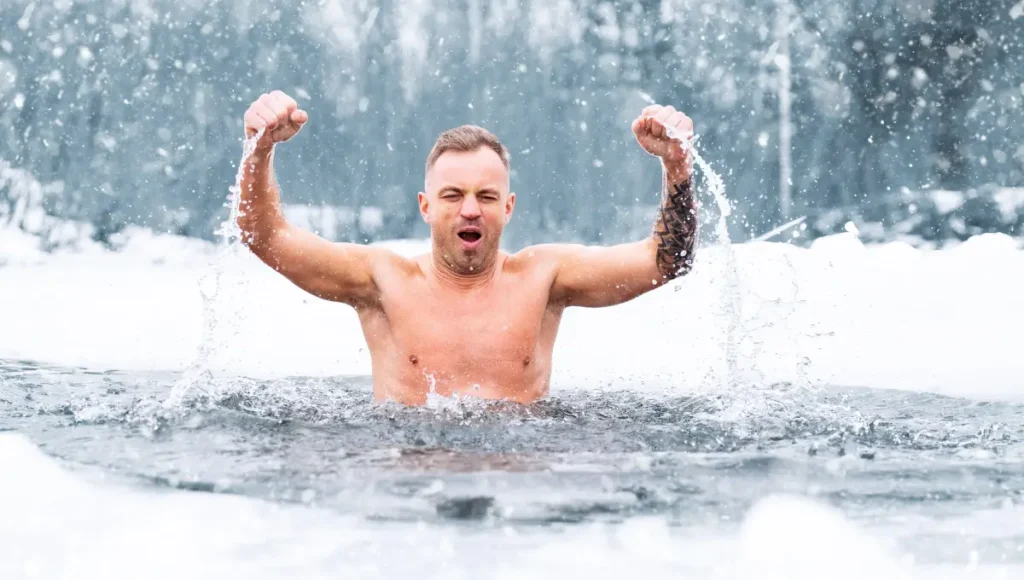Swimming is a beloved activity enjoyed by people of all ages, providing not only a refreshing way to cool off but also an excellent form of exercise.
However, even seasoned swimmers can fall victim to common mistakes that hinder their progress and compromise safety.
In this article, we’ll explore the most common swimming mistakes and provide valuable insights on how to correct them.
- 📃 Here Are The 11 Most Common Swimming Mistakes
- 1. Cutting the symmetry line
- 2. “Stop!” – Raising your palm in the water
- 3. Head held too high
- 4. A bobbing head
- 5. Before the palm, the elbow touches the water.
- 6. Bendy legs – “Bicycle”
- 7. The arm falls while breathing
- 8. Head goes too high while breathing
- 9. Looking back while breathing
- 10. Too many strokes for each length
- 11. Inconsistent Pacing
- 🙋🏻♀️ FAQs For Most Common Swimming Mistakes
- Q. What is the most common kicking mistake in swimming?
- Q. What is the common mistake in freestyle swimming?
- Q. What are the 4 major risks in swimming?
- Q. What is the number one rule on swimming?
- Q. How can I improve my breathing while swimming?
- Q. Is it necessary to warm up before swimming?
- Q. What role does body position play in swimming?
- Q. How often should I practice swimming to see improvement?
- Q. Are flip turns essential for lap swimming?
- Q. What is the proper etiquette for sharing a swimming lane?
- 😇 Conclusion
- ✉ Which swim shirt is the best for men, in your opinion? Tell us in the comments.
📃 Here Are The 11 Most Common Swimming Mistakes
According to swimming experts, the following are some common swimming mistakes that people make, either deliberately or unknowingly.
After doing a lot of research and considering buyer reviews we have shortlisted some of the most common swimming mistakes.
- Cutting the symmetry line
- “Stop!” – Raising your palm in the water
- Head held too high
- A bobbing head
- Before the palm, the elbow touches the water.
- Bendy legs – “Bicycle”
- The arm falls while breathing
- Head goes too high while breathing
- Looking back while breathing
- Too many strokes for each length
- Inconsistent Pacing
1. Cutting the symmetry line
A hypothetical line that passes through the body’s middle is known as the symmetry line. Because they don’t know about this boundary, many swimmers cross it by putting their right hand on the left side and vice versa.
How to Fix :
Slowly extend your arms, focusing on the glide’s conclusion. In this manner, the symmetry line won’t be crossed as you connect your shoulder to your cheek or chin. Stretch your right arm to “one o’clock” and your left hand to “eleven o’clock” if the previous step doesn’t work. This overcompensation enables us to stretch the limbs correctly and effectively in both directions without crossing the mid-body line.
2. “Stop!” – Raising your palm in the water
After the glide, 80% of swimmers raise their palms to make a “stop”. If we approach it from the WEST, it puts a lot of weight on the shoulders and causes the lower back to arch. The resultant sinking of the thighs necessitates vigorous legwork and a lot of oxygen. In this manner, they find it difficult to move forward and quickly become exhausted.
How to Fix :
According to the WEST method, the solution is straightforward: extend your arm to a depth that is appropriate for you based on your degree of flexibility. If you are unsure of your exact depth, simply stretch 15 cm lower than you usually would. You may lose some traction as a result, but you also avoid pressure on your neck and lower back and avoid making the “Stop” gesture, which significantly slows you down.
3. Head held too high
When swimming for extended distances or in open water, our survival instinct causes us to lift our heads. In the past, swimmers would hold their heads aloft to elevate their entire bodies. According to WEST, lifting the head puts strain on the neck and lower back sinks the feet, and slows swimming down by making us work much harder.
How to Fix :
The bottom of the pool is where you want to investigate. Making sure that we can only see the elbow and not the palm when we stretch the arm out to a depth of 35 cm is an effective method to verify this.
Another smart move is to ask a buddy to record you for 15 or 30 seconds so you can see if your head is positioned properly.
Looking down while swimming helps generate better elevation, permits more relaxed legwork, releases the lower back, and eventually speeds up swimming.
4. A bobbing head
We frequently extend the arm and raise it (see mistake 2). Many swimmers tend to stretch out excessively and thrust their alms into the water, which causes the head to bob up and down. Additionally, their body sways back and forth like a worm, which can put a tremendous amount of strain on the spine. In this manner, each stroke causes them to lift their body off the ground instead of moving forward, which significantly slows down the speed.
How to Fix :
Fix this by keeping your head balanced and lowering your hand slowly into the water with a relaxed palm. gently touching the water’s edge. Eventually, this will stop your cranium from falling.
5. Before the palm, the elbow touches the water.
Because they don’t have the same level of flexibility as Olympic swimmers, many swimmers try to stretch their hands out without taking into account their level of flexibility. As a result, many times their elbow touches the water first, falls, drags in the water, and stops them before they even start the stroke, slows them down, and causes them to sink. Additionally, this puts strain on the shoulders and neck, which is something that West Swimming aims to avoid.
How to Fix :
We will insert it with the palm closer to the head, at a 120 angle, and try to make sure the palm touches the water first. An Olympic swimmer will insert his hand when it is at a 170-degree angle (angle between the arm and the forearm). In actuality, we don’t begin the stretch until the arm is submerged. By doing it this way, we avoid applying pressure to the neck and shoulders, avoid using our hand and arm as a “stop,” and each stroke advances us further.
6. Bendy legs – “Bicycle”
A lot of swimmers like to combine breaststroke and freestyle by bending their legs in an action akin to bicycling.
How to Fix :
First and foremost, we advise swimming entirely without any effort. If you adhere to the WEST principles—a correct stretch depth, relaxed palms by your degree of flexibility, and a downward gaze—the legs will float, allowing you to drag them behind you with ease. Even better, you can maintain a straight posture while extending your thigh muscles to achieve the precise bend you require to improve your swimming.
Another suggestion is to swim while wearing fins; after each stretch, kick slightly with your legs while keeping your feet pointed. Using fins while swimming will give your ankles the proper elasticity and prevent them from bending. Of course, it’s crucial to realize that you can perform the same actions without the fins.
7. The arm falls while breathing
To safeguard the neck and obtain more air, it’s critical to understand when and how to breathe. Many swimmers reach a stage where they start to feel oxygen-deprived. They exhale, raising both of their eyes above the surface before letting go of their front limb.
How to Fix :
Simply extend more slowly, for the first few times touching your ear to your shoulder if you notice that you do indeed lose the stretch while breathing. The shoulder will feel a little tighter as a result, but you should only do this initially. Additionally, it will stop your arm from drooping, stop you from stopping or working with your neck, and allow you to breathe more freely.
8. Head goes too high while breathing
Our natural tendency is to breathe in as much air as we can while keeping one eye on the ocean. Water enters our noses frequently, causing us to raise our heads. As a result, we swallow water and nearly come to a complete stop with each breath. This also causes the arm to droop and the head to immediately sink.
How to Fix :
You should practice breathing with one eye in the water, your mouth and nose out, your palm stretched out, and your shoulders relaxed. To train your body to kick at a 90-degree angle, you can do this a few times with fins or even while holding a small buoy in your palm. When you get used to it, you’ll notice that you can do it without fins, that you can breathe much deeper, and that your hand won’t descend while you’re doing it.
9. Looking back while breathing
This scenario can arise for a variety of causes, including unintentionally protecting the mouth and nose or cutting the symmetry line with the front hand while breathing. We attempt to prevent whiplash when swimming with the WEST technique because this movement puts a lot of pressure on the neck and feels very similar to one. Both swimmers who breathe every two strokes and swimmers who breathe every three strokes make this error frequently.
How to Fix :
Make careful to breathe at a 90-degree angle if you breathe to the back. You should have a buddy video because it is difficult to determine this on your own.
In west swimming, the objective is to breathe with no neck strain. Have a friend walk alongside you on the poolside to ensure that your head is in the proper posture. You should always be gazing at his knees when you go outside to breathe.
By breathing correctly, you can get much more air and avoid fatigue, tension in the neck and lower back, and sinking.
10. Too many strokes for each length
The number of strokes required for each pool length is one of the factors that determine the quality of our swimming skills, flotation, and pull. To protect our plexus area, the body will shorten our stroke if we try to stretch forward too far. As a result, we end up making more strokes and getting tired quickly.
How to Fix :
Make careful to calmly place your hand into the water. Additionally, the stretch’s conclusion is crucial. To lengthen our body, improve our ability to float, and use fewer strokes, we want to stretch the hand as gently as possible. Our muscles gradually grow longer as a result, the body oxidizes more slowly, and ultimately we swim much faster. Finding the right stretch depth for this exercise depends on how flexible your WEST is.
11. Inconsistent Pacing
“In a triathlon, adrenaline, and enthusiasm may cause swimmers to start too quickly, but they frequently end up blowing up, according to Furniss. Before the cycle or the run, too. You’ll have a much more effective race if you can learn to pace yourself properly.” No matter how tempting it might be, resist the urge to start a race’s swim portion too quickly. Start the swim at a slower speed and add a stronger kick halfway through as you begin to increase your effort.
How to Fix :
Swim negative splits to simulate race speed during workouts. When swimming 10 x 100 meters, pick up the speed gradually throughout the set, making sure to swim each 100 meters a little faster than the one before it. By doing so, you’ll develop awareness and a sense of the speed you can keep up.
🙋🏻♀️ FAQs For Most Common Swimming Mistakes
Many issues about swimming mistakes cross people’s minds; some of the most frequently questioned ones are addressed here.
Q. What is the most common kicking mistake in swimming?
A. The most common kicking mistake in swimming is improper flutter kicking, often caused by inflexible ankles or excessive knee bending.
Q. What is the common mistake in freestyle swimming?
A. A common mistake in freestyle swimming is overreaching, which can lead to increased drag and decreased efficiency in strokes.
Q. What are the 4 major risks in swimming?
A. The 4 major risks in swimming include drowning, hypothermia, muscle cramps, and sunburn.
Q. What is the number one rule on swimming?
A. The number one rule in swimming is to prioritize safety, emphasizing the importance of vigilance, proper supervision, and adherence to swimming guidelines.
Q. How can I improve my breathing while swimming?
A. Mastering breathing techniques takes practice. Focus on exhaling fully underwater and inhaling quickly when turning your head to the side.
Q. Is it necessary to warm up before swimming?
A. Yes, warming up is crucial. It prepares your muscles for the activity, reducing the risk of injuries.
Q. What role does body position play in swimming?
A. Body position affects your speed and efficiency. Keep your body streamlined to minimize drag and move through the water more effectively.
Q. How often should I practice swimming to see improvement?
A. Consistency is key. Aim for at least three to four sessions per week to notice significant improvements in your technique and performance.
Q. Are flip turns essential for lap swimming?
A. While not mandatory, mastering flip turns can significantly improve your lap times and overall swimming experience.
Q. What is the proper etiquette for sharing a swimming lane?
A. Always be aware of other swimmers, choose an appropriate lane based on your speed, and communicate with fellow swimmers to avoid collisions.
😇 Conclusion
Enhancing your swimming technique requires a combination of knowledge, practice, and dedication. By understanding and rectifying common mistakes, you’ll embark on a journey to becoming a more efficient and confident swimmer.
✉ Which swim shirt is the best for men, in your opinion? Tell us in the comments.
Also, don’t forget to check other articles on World Sports Gear. Enhance your knowledge about swimming and other related sports.



